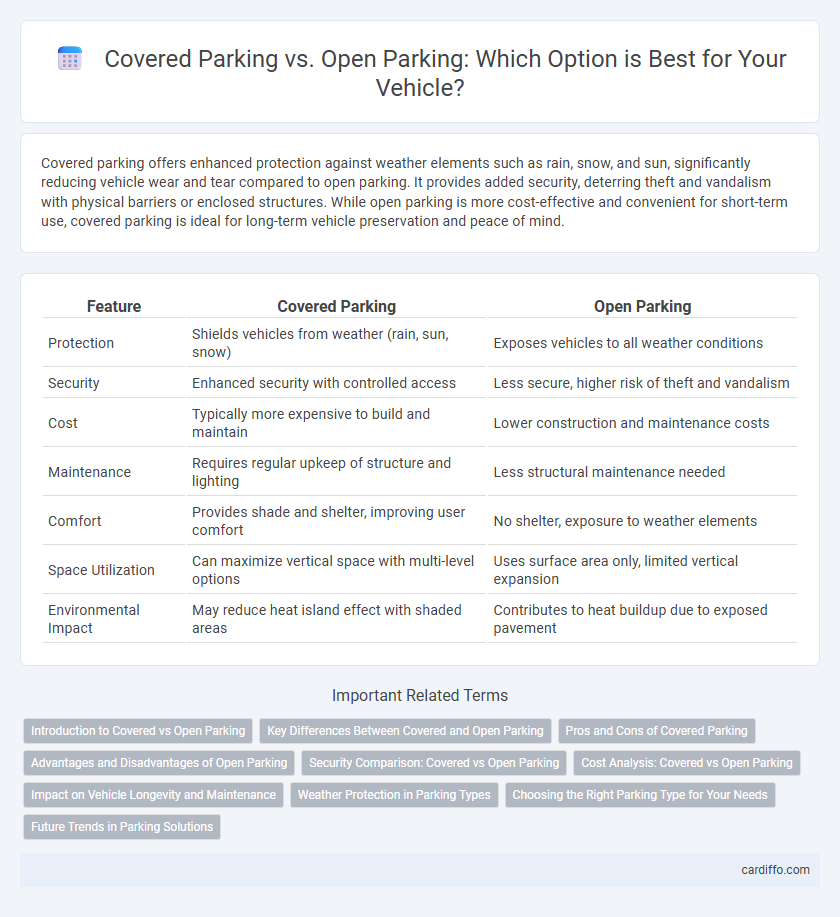Covered parking offers enhanced protection against weather elements such as rain, snow, and sun, significantly reducing vehicle wear and tear compared to open parking. It provides added security, deterring theft and vandalism with physical barriers or enclosed structures. While open parking is more cost-effective and convenient for short-term use, covered parking is ideal for long-term vehicle preservation and peace of mind.
Table of Comparison
| Feature | Covered Parking | Open Parking |
|---|---|---|
| Protection | Shields vehicles from weather (rain, sun, snow) | Exposes vehicles to all weather conditions |
| Security | Enhanced security with controlled access | Less secure, higher risk of theft and vandalism |
| Cost | Typically more expensive to build and maintain | Lower construction and maintenance costs |
| Maintenance | Requires regular upkeep of structure and lighting | Less structural maintenance needed |
| Comfort | Provides shade and shelter, improving user comfort | No shelter, exposure to weather elements |
| Space Utilization | Can maximize vertical space with multi-level options | Uses surface area only, limited vertical expansion |
| Environmental Impact | May reduce heat island effect with shaded areas | Contributes to heat buildup due to exposed pavement |
Introduction to Covered vs Open Parking
Covered parking offers protection from weather elements such as rain, snow, and sun, preserving vehicle condition and enhancing security. Open parking provides easier access and often higher availability but exposes vehicles to environmental factors and potential damage. Choosing between covered and open parking depends on factors like budget, location, and the importance of vehicle protection.
Key Differences Between Covered and Open Parking
Covered parking offers protection from weather elements like rain, snow, and UV rays, reducing vehicle damage and improving longevity. Open parking spaces expose vehicles to environmental factors but often provide more flexible and cost-effective options with easier access. Choosing between covered and open parking depends on factors such as climate, budget, security needs, and convenience preferences.
Pros and Cons of Covered Parking
Covered parking offers significant protection against weather elements, reducing vehicle damage from sun exposure, rain, snow, and hail, which can extend the lifespan of paint and interior materials. However, covered parking typically involves higher installation and maintenance costs compared to open parking and may require more space, limiting flexibility in urban settings. Despite these drawbacks, covered parking enhances vehicle security and comfort, making it a valuable option in areas prone to harsh weather conditions.
Advantages and Disadvantages of Open Parking
Open parking offers advantages such as lower construction and maintenance costs compared to covered parking, allowing for more flexible space utilization and easier access for vehicles. However, its disadvantages include exposure to weather elements like rain, snow, and sun, which can lead to vehicle damage and decreased comfort for users. Open parking areas may also face higher risks of security issues and debris accumulation, requiring more frequent cleaning and surveillance.
Security Comparison: Covered vs Open Parking
Covered parking offers enhanced security by providing physical barriers that deter theft, vandalism, and weather-related damage compared to open parking lots. Surveillance systems and controlled access points are more effectively implemented in covered parking structures, reducing unauthorized entry. Open parking areas, while more accessible, often expose vehicles to higher risks due to lack of protection and limited security measures.
Cost Analysis: Covered vs Open Parking
Covered parking typically incurs higher initial construction and maintenance costs compared to open parking due to materials, roofing, and structural support requirements. Open parking offers lower expenses with minimal infrastructure, relying mainly on paving and line markings. Over time, covered parking may provide cost benefits by protecting vehicles from weather damage, potentially reducing insurance premiums and enhancing vehicle lifespan.
Impact on Vehicle Longevity and Maintenance
Covered parking significantly enhances vehicle longevity by protecting cars from harsh weather elements like UV rays, rain, and snow, which cause paint fading and rust. This shelter reduces the frequency of maintenance tasks such as washing, waxing, and rust treatment, preserving the vehicle's exterior and mechanical components. Open parking exposes vehicles to environmental stressors, accelerating deterioration and increasing long-term maintenance costs.
Weather Protection in Parking Types
Covered parking offers superior weather protection by shielding vehicles from rain, snow, hail, and harmful UV rays, preserving paint and interior quality. Open parking exposes vehicles to the elements, increasing risks of weather-related damage and accelerating wear and tear. Choosing covered parking significantly reduces maintenance costs and enhances vehicle longevity by minimizing exposure to harsh weather conditions.
Choosing the Right Parking Type for Your Needs
Choosing between covered parking and open parking depends on factors such as weather protection, security, and cost. Covered parking offers shelter from elements like rain, snow, and UV rays, helping to preserve vehicle condition, while open parking is generally more affordable and accessible. Assess your priorities related to vehicle protection, convenience, and budget to select the most suitable parking type.
Future Trends in Parking Solutions
Future trends in parking solutions emphasize the integration of smart technologies within covered parking structures, offering enhanced vehicle protection and automated space management. Open parking areas are increasingly incorporating solar panel canopies to generate renewable energy while providing partial shelter, reflecting a shift towards sustainable infrastructure. The convergence of IoT sensors and AI-driven platforms in both covered and open parking systems facilitates real-time availability tracking and dynamic pricing models, optimizing user experience and operational efficiency.
Covered Parking vs Open Parking Infographic

 cardiffo.com
cardiffo.com